warning light FIAT DUCATO BASE CAMPER 2015 Owner handbook (in English)
[x] Cancel search | Manufacturer: FIAT, Model Year: 2015, Model line: DUCATO BASE CAMPER, Model: FIAT DUCATO BASE CAMPER 2015Pages: 367, PDF Size: 19.73 MB
Page 67 of 367
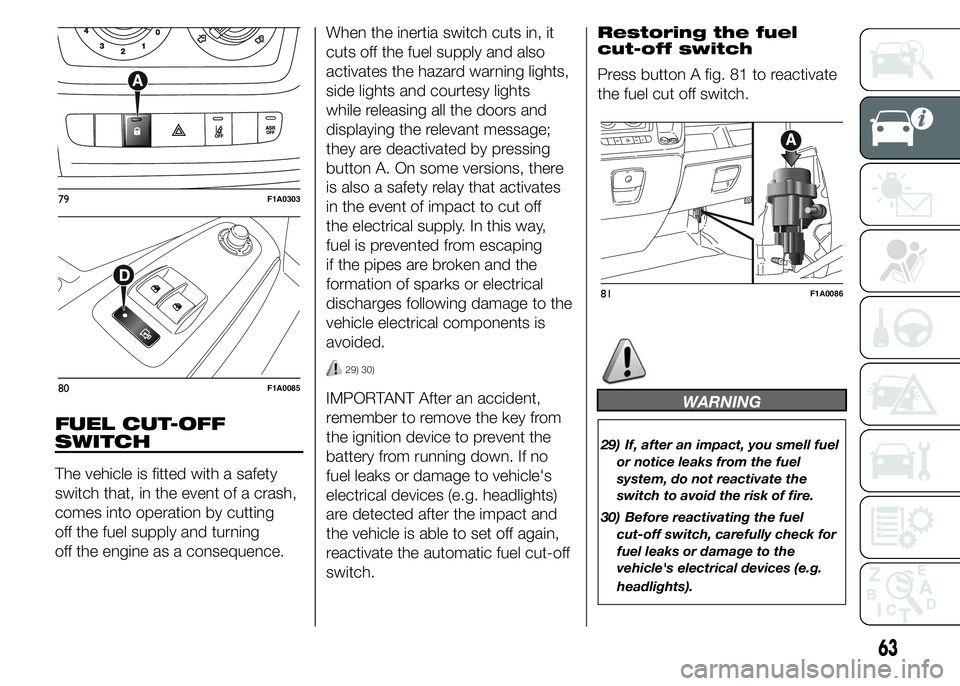
FUEL CUT-OFF
SWITCH
The vehicle is fitted with a safety
switch that, in the event of a crash,
comes into operation by cutting
off the fuel supply and turning
off the engine as a consequence.When the inertia switch cuts in, it
cuts off the fuel supply and also
activates the hazard warning lights,
side lights and courtesy lights
while releasing all the doors and
displaying the relevant message;
they are deactivated by pressing
button A. On some versions, there
is also a safety relay that activates
in the event of impact to cut off
the electrical supply. In this way,
fuel is prevented from escaping
if the pipes are broken and the
formation of sparks or electrical
discharges following damage to the
vehicle electrical components is
avoided.
29) 30)
IMPORTANT After an accident,
remember to remove the key from
the ignition device to prevent the
battery from running down. If no
fuel leaks or damage to vehicle's
electrical devices (e.g. headlights)
are detected after the impact and
the vehicle is able to set off again,
reactivate the automatic fuel cut-off
switch.Restoring the fuel
cut-off switch
Press button A fig. 81 to reactivate
the fuel cut off switch.WARNING
29) If, after an impact, you smell fuel
or notice leaks from the fuel
system, do not reactivate the
switch to avoid the risk of fire.
30) Before reactivating the fuel
cut-off switch, carefully check for
fuel leaks or damage to the
vehicle's electrical devices (e.g.
headlights).
79F1A0303
80F1A0085
81F1A0086
63
Page 73 of 367
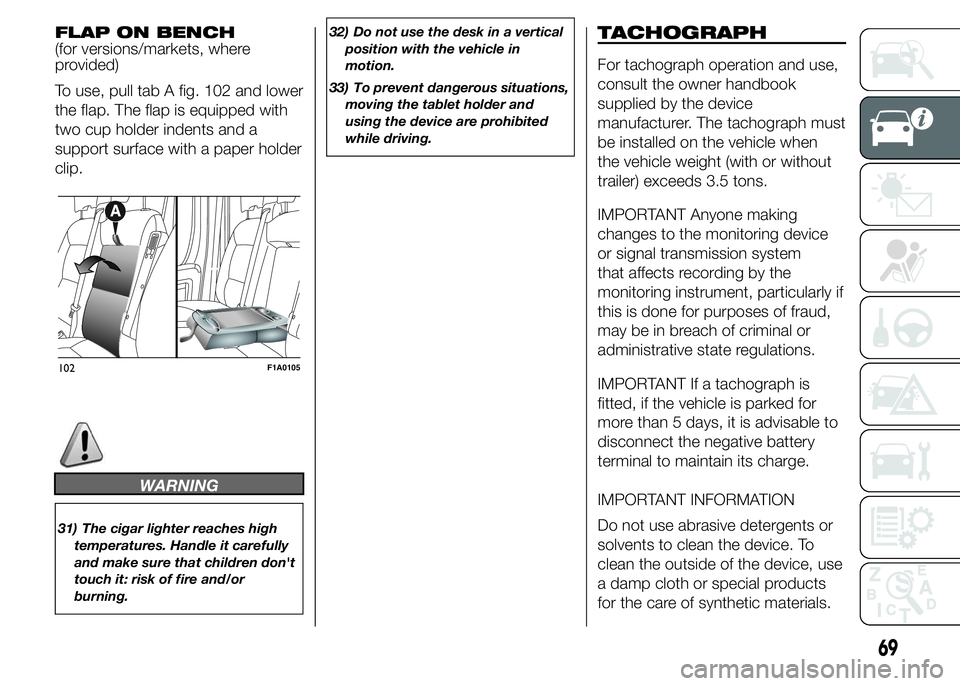
FLAP ON BENCH
(for versions/markets, where
provided)
To use, pull tab A fig. 102 and lower
the flap. The flap is equipped with
two cup holder indents and a
support surface with a paper holder
clip.
WARNING
31) The cigar lighter reaches high
temperatures. Handle it carefully
and make sure that children don't
touch it: risk of fire and/or
burning.32) Do not use the desk in a vertical
position with the vehicle in
motion.
33) To prevent dangerous situations,
moving the tablet holder and
using the device are prohibited
while driving.
TACHOGRAPH
For tachograph operation and use,
consult the owner handbook
supplied by the device
manufacturer. The tachograph must
be installed on the vehicle when
the vehicle weight (with or without
trailer) exceeds 3.5 tons.
IMPORTANT Anyone making
changes to the monitoring device
or signal transmission system
that affects recording by the
monitoring instrument, particularly if
this is done for purposes of fraud,
may be in breach of criminal or
administrative state regulations.
IMPORTANT If a tachograph is
fitted, if the vehicle is parked for
more than 5 days, it is advisable to
disconnect the negative battery
terminal to maintain its charge.
IMPORTANT INFORMATION
Do not use abrasive detergents or
solvents to clean the device. To
clean the outside of the device, use
a damp cloth or special products
for the care of synthetic materials.
102F1A0105
69
Page 77 of 367
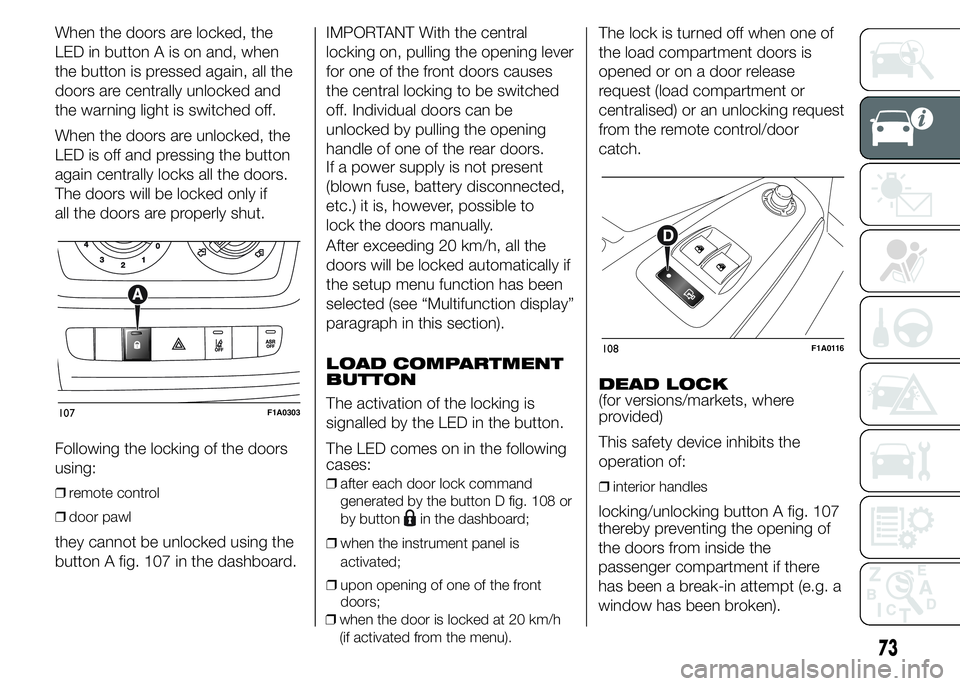
When the doors are locked, the
LED in button A is on and, when
the button is pressed again, all the
doors are centrally unlocked and
the warning light is switched off.
When the doors are unlocked, the
LED is off and pressing the button
again centrally locks all the doors.
The doors will be locked only if
all the doors are properly shut.
Following the locking of the doors
using:
❒remote control
❒door pawl
they cannot be unlocked using the
button A fig. 107 in the dashboard.IMPORTANT With the central
locking on, pulling the opening lever
for one of the front doors causes
the central locking to be switched
off. Individual doors can be
unlocked by pulling the opening
handle of one of the rear doors.
If a power supply is not present
(blown fuse, battery disconnected,
etc.) it is, however, possible to
lock the doors manually.
After exceeding 20 km/h, all the
doors will be locked automatically if
the setup menu function has been
selected (see “Multifunction display”
paragraph in this section).
LOAD COMPARTMENT
BUTTON
The activation of the locking is
signalled by the LED in the button.
The LED comes on in the following
cases:
❒after each door lock command
generated by the button D fig. 108 or
by button
in the dashboard;
❒when the instrument panel is
activated;
❒upon opening of one of the front
doors;
❒when the door is locked at 20 km/h
(if activated from the menu).
The lock is turned off when one of
the load compartment doors is
opened or on a door release
request (load compartment or
centralised) or an unlocking request
from the remote control/door
catch.
DEAD LOCK
(for versions/markets, where
provided)
This safety device inhibits the
operation of:
❒interior handles
locking/unlocking button A fig. 107
107F1A0303
108F1A0116
73
thereby preventing the opening of
the doors from inside the
passenger compartment if there
has been a break-in attempt (e.g. a
window has been broken).
Page 81 of 367
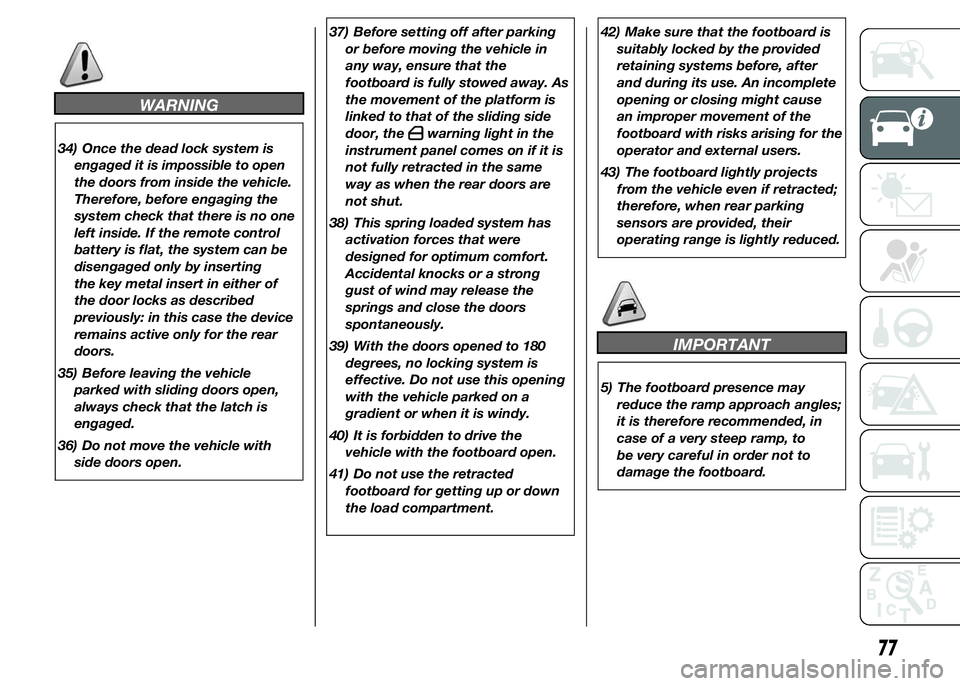
WARNING
34) Once the dead lock system is
engaged it is impossible to open
the doors from inside the vehicle.
Therefore, before engaging the
system check that there is no one
left inside. If the remote control
battery is flat, the system can be
disengaged only by inserting
the key metal insert in either of
the door locks as described
previously: in this case the device
remains active only for the rear
doors.
35) Before leaving the vehicle
parked with sliding doors open,
always check that the latch is
engaged.
36) Do not move the vehicle with
side doors open.37) Before setting off after parking
or before moving the vehicle in
any way, ensure that the
footboard is fully stowed away. As
the movement of the platform is
linked to that of the sliding side
door, thewarning light in the
instrument panel comes on if it is
not fully retracted in the same
way as when the rear doors are
not shut.
38) This spring loaded system has
activation forces that were
designed for optimum comfort.
Accidental knocks or a strong
gust of wind may release the
springs and close the doors
spontaneously.
39) With the doors opened to 180
degrees, no locking system is
effective. Do not use this opening
with the vehicle parked on a
gradient or when it is windy.
40) It is forbidden to drive the
vehicle with the footboard open.
41) Do not use the retracted
footboard for getting up or down
the load compartment.42) Make sure that the footboard is
suitably locked by the provided
retaining systems before, after
and during its use. An incomplete
opening or closing might cause
an improper movement of the
footboard with risks arising for the
operator and external users.
43) The footboard lightly projects
from the vehicle even if retracted;
therefore, when rear parking
sensors are provided, their
operating range is lightly reduced.
IMPORTANT
5) The footboard presence may
reduce the ramp approach angles;
it is therefore recommended, in
case of a very steep ramp, to
be very careful in order not to
damage the footboard.
77
Page 86 of 367
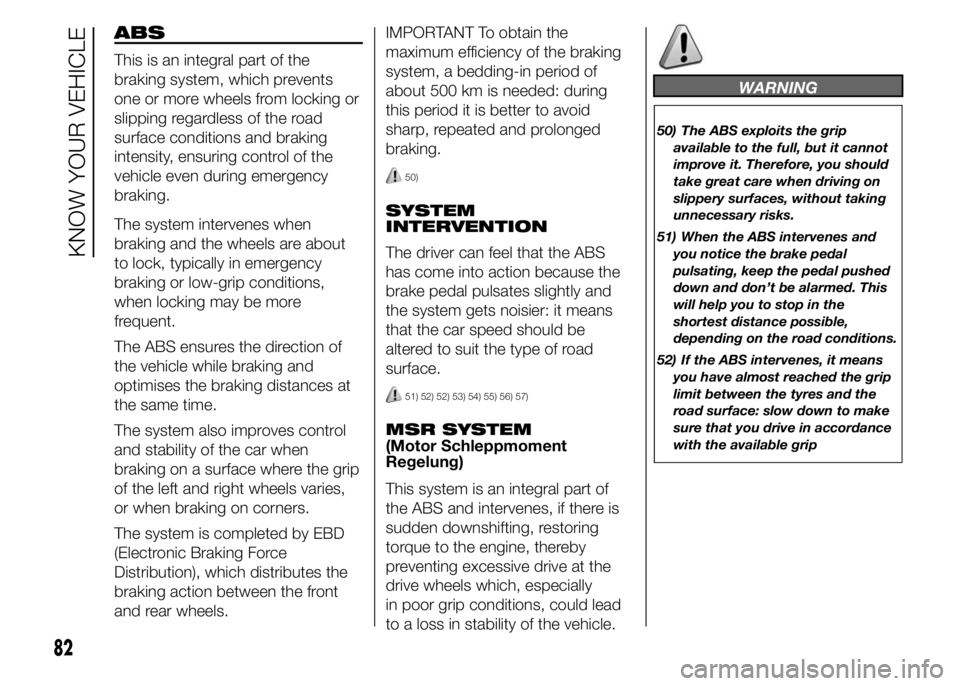
ABS
This is an integral part of the
braking system, which prevents
one or more wheels from locking or
slipping regardless of the road
surface conditions and braking
intensity, ensuring control of the
vehicle even during emergency
braking.
The system intervenes when
braking and the wheels are about
to lock, typically in emergency
braking or low-grip conditions,
when locking may be more
frequent.
The ABS ensures the direction of
the vehicle while braking and
optimises the braking distances at
the same time.
The system also improves control
and stability of the car when
braking on a surface where the grip
of the left and right wheels varies,
or when braking on corners.
The system is completed by EBD
(Electronic Braking Force
Distribution), which distributes the
braking action between the front
and rear wheels.IMPORTANT To obtain the
maximum efficiency of the braking
system, a bedding-in period of
about 500 km is needed: during
this period it is better to avoid
sharp, repeated and prolonged
braking.
50)
SYSTEM
INTERVENTION
The driver can feel that the ABS
has come into action because the
brake pedal pulsates slightly and
the system gets noisier: it means
that the car speed should be
altered to suit the type of road
surface.
51) 52) 52) 53) 54) 55) 56) 57)
MSR SYSTEM
(Motor Schleppmoment
Regelung)
This system is an integral part of
the ABS and intervenes, if there is
sudden downshifting, restoring
torque to the engine, thereby
preventing excessive drive at the
drive wheels which, especially
in poor grip conditions, could lead
to a loss in stability of the vehicle.
WARNING
50) The ABS exploits the grip
available to the full, but it cannot
improve it. Therefore, you should
take great care when driving on
slippery surfaces, without taking
unnecessary risks.
51) When the ABS intervenes and
you notice the brake pedal
pulsating, keep the pedal pushed
down and don’t be alarmed. This
will help you to stop in the
shortest distance possible,
depending on the road conditions.
52) If the ABS intervenes, it means
you have almost reached the grip
limit between the tyres and the
road surface: slow down to make
sure that you drive in accordance
with the available grip
82
KNOW YOUR VEHICLE
Page 87 of 367
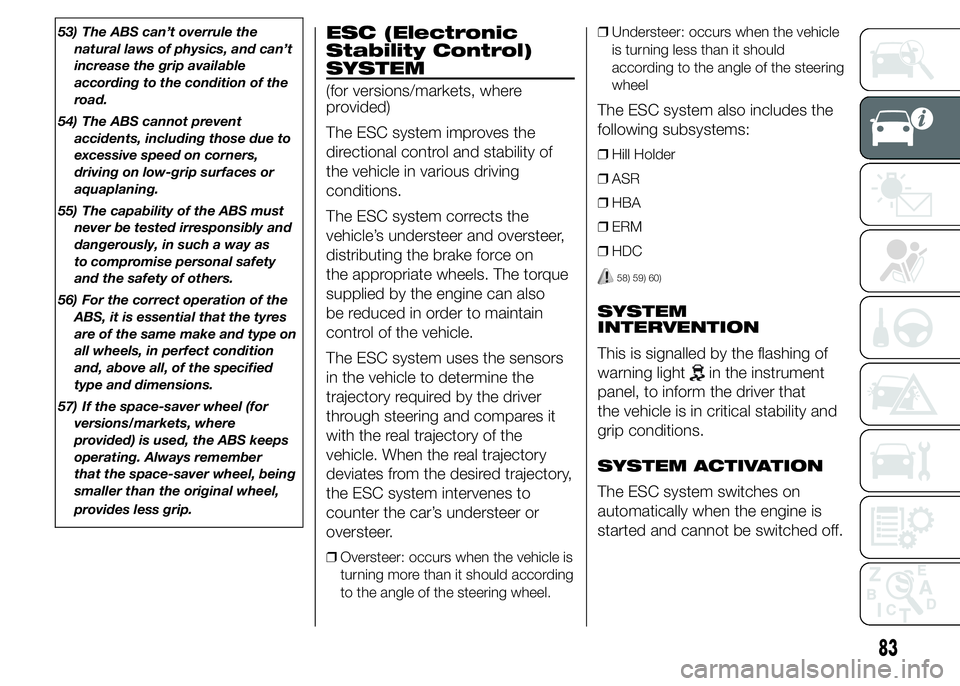
53) The ABS can’t overrule the
natural laws of physics, and can’t
increase the grip available
according to the condition of the
road.
54) The ABS cannot prevent
accidents, including those due to
excessive speed on corners,
driving on low-grip surfaces or
aquaplaning.
55) The capability of the ABS must
never be tested irresponsibly and
dangerously, in such a way as
to compromise personal safety
and the safety of others.
56) For the correct operation of the
ABS, it is essential that the tyres
are of the same make and type on
all wheels, in perfect condition
and, above all, of the specified
type and dimensions.
57) If the space-saver wheel (for
versions/markets, where
provided) is used, the ABS keeps
operating. Always remember
that the space-saver wheel, being
smaller than the original wheel,
provides less grip.ESC (Electronic
Stability Control)
SYSTEM
(for versions/markets, where
provided)
The ESC system improves the
directional control and stability of
the vehicle in various driving
conditions.
The ESC system corrects the
vehicle’s understeer and oversteer,
distributing the brake force on
the appropriate wheels. The torque
supplied by the engine can also
be reduced in order to maintain
control of the vehicle.
The ESC system uses the sensors
in the vehicle to determine the
trajectory required by the driver
through steering and compares it
with the real trajectory of the
vehicle. When the real trajectory
deviates from the desired trajectory,
the ESC system intervenes to
counter the car’s understeer or
oversteer.
❒Oversteer: occurs when the vehicle is
turning more than it should according
to the angle of the steering wheel.❒Understeer: occurs when the vehicle
is turning less than it should
according to the angle of the steering
wheel
The ESC system also includes the
following subsystems:
❒Hill Holder
❒ASR
❒HBA
❒ERM
❒HDC
58) 59) 60)
SYSTEM
INTERVENTION
This is signalled by the flashing of
warning light
in the instrument
panel, to inform the driver that
the vehicle is in critical stability and
grip conditions.
SYSTEM ACTIVATION
The ESC system switches on
automatically when the engine is
started and cannot be switched off.
83
Page 90 of 367
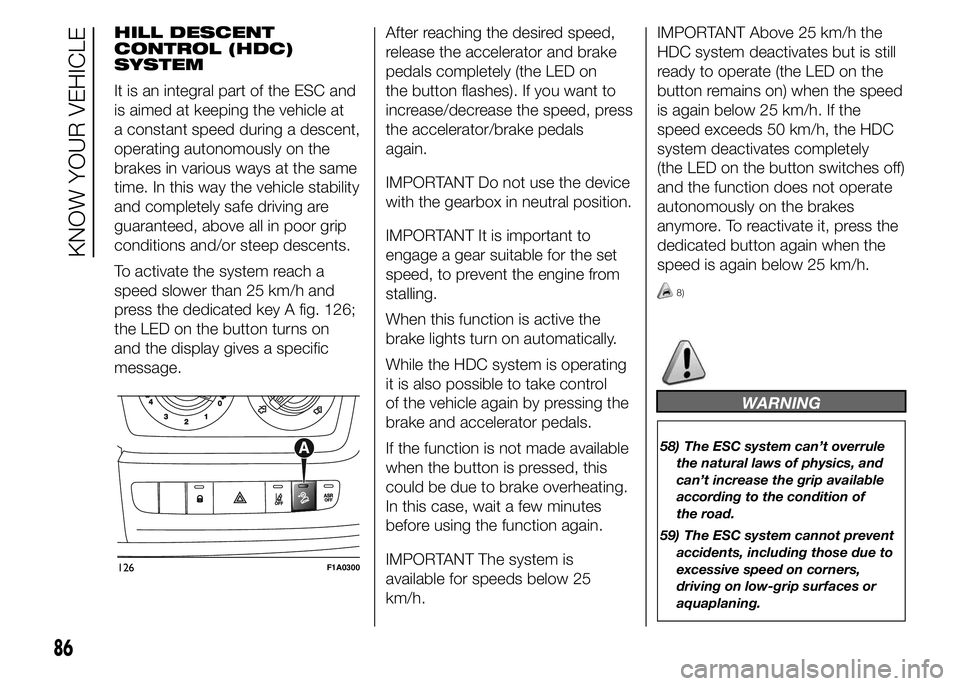
HILL DESCENT
CONTROL (HDC)
SYSTEM
It is an integral part of the ESC and
is aimed at keeping the vehicle at
a constant speed during a descent,
operating autonomously on the
brakes in various ways at the same
time. In this way the vehicle stability
and completely safe driving are
guaranteed, above all in poor grip
conditions and/or steep descents.
To activate the system reach a
speed slower than 25 km/h and
press the dedicated key A fig. 126;
the LED on the button turns on
and the display gives a specific
message.After reaching the desired speed,
release the accelerator and brake
pedals completely (the LED on
the button flashes). If you want to
increase/decrease the speed, press
the accelerator/brake pedals
again.
IMPORTANT Do not use the device
with the gearbox in neutral position.
IMPORTANT It is important to
engage a gear suitable for the set
speed, to prevent the engine from
stalling.
When this function is active the
brake lights turn on automatically.
While the HDC system is operating
it is also possible to take control
of the vehicle again by pressing the
brake and accelerator pedals.
If the function is not made available
when the button is pressed, this
could be due to brake overheating.
In this case, wait a few minutes
before using the function again.
IMPORTANT The system is
available for speeds below 25
km/h.IMPORTANT Above 25 km/h the
HDC system deactivates but is still
ready to operate (the LED on the
button remains on) when the speed
is again below 25 km/h. If the
speed exceeds 50 km/h, the HDC
system deactivates completely
(the LED on the button switches off)
and the function does not operate
autonomously on the brakes
anymore. To reactivate it, press the
dedicated button again when the
speed is again below 25 km/h.
8)
WARNING
58) The ESC system can’t overrule
the natural laws of physics, and
can’t increase the grip available
according to the condition of
the road.
59) The ESC system cannot prevent
accidents, including those due to
excessive speed on corners,
driving on low-grip surfaces or
aquaplaning.
126F1A0300
86
KNOW YOUR VEHICLE
Page 92 of 367
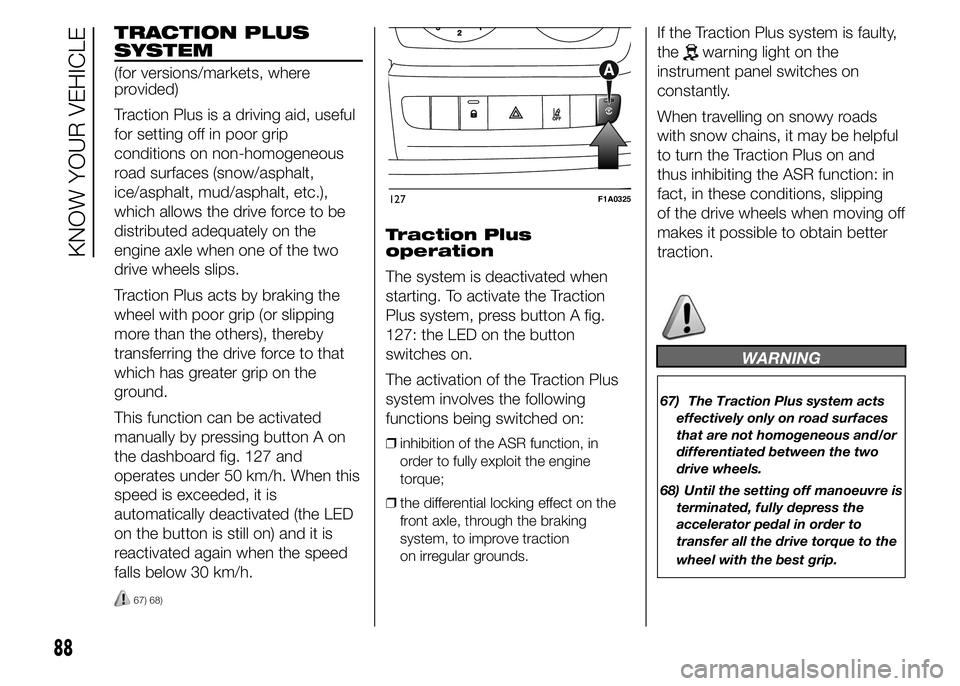
TRACTION PLUS
SYSTEM
(for versions/markets, where
provided)
Traction Plus is a driving aid, useful
for setting off in poor grip
conditions on non-homogeneous
road surfaces (snow/asphalt,
ice/asphalt, mud/asphalt, etc.),
which allows the drive force to be
distributed adequately on the
engine axle when one of the two
drive wheels slips.
Traction Plus acts by braking the
wheel with poor grip (or slipping
more than the others), thereby
transferring the drive force to that
which has greater grip on the
ground.
This function can be activated
manually by pressing button A on
the dashboard fig. 127 and
operates under 50 km/h. When this
speed is exceeded, it is
automatically deactivated (the LED
on the button is still on) and it is
reactivated again when the speed
falls below 30 km/h.
67) 68)
Traction Plus
operation
The system is deactivated when
starting. To activate the Traction
Plus system, press button A fig.
127: the LED on the button
switches on.
The activation of the Traction Plus
system involves the following
functions being switched on:
❒inhibition of the ASR function, in
order to fully exploit the engine
torque;
❒the differential locking effect on the
front axle, through the braking
system, to improve traction
on irregular grounds.
If the Traction Plus system is faulty,
the
warning light on the
instrument panel switches on
constantly.
When travelling on snowy roads
with snow chains, it may be helpful
to turn the Traction Plus on and
thus inhibiting the ASR function: in
fact, in these conditions, slipping
of the drive wheels when moving off
makes it possible to obtain better
traction.
WARNING
67) The Traction Plus system acts
effectively only on road surfaces
that are not homogeneous and/or
differentiated between the two
drive wheels.
68) Until the setting off manoeuvre is
terminated, fully depress the
accelerator pedal in order to
transfer all the drive torque to the
wheel with the best grip.
127F1A0325
88
KNOW YOUR VEHICLE
Page 93 of 367
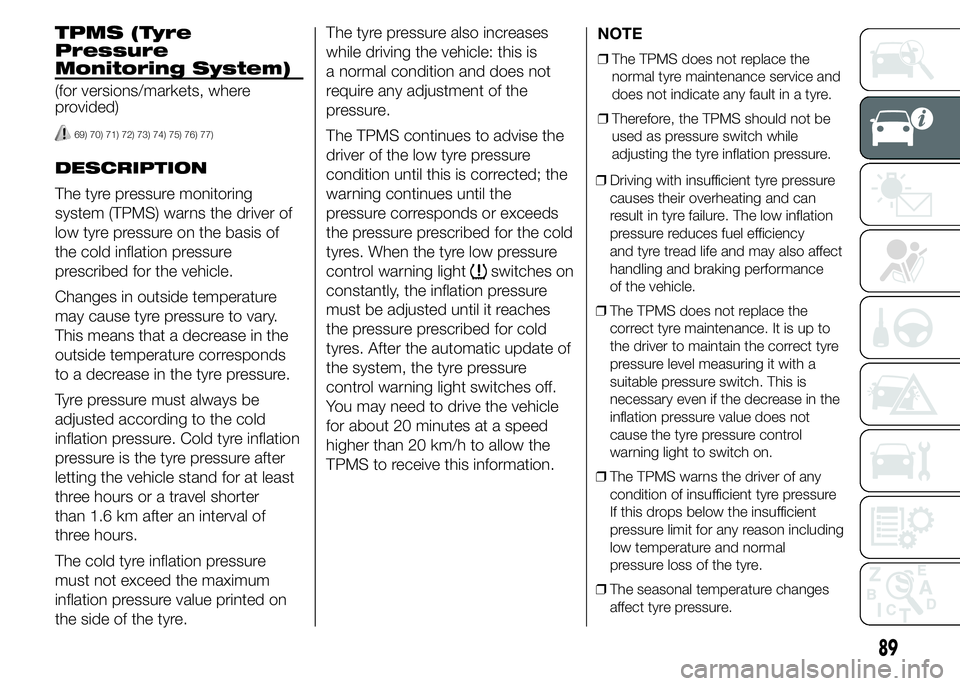
TPMS (Tyre
Pressure
Monitoring System)
(for versions/markets, where
provided)
69) 70) 71) 72) 73) 74) 75) 76) 77)
DESCRIPTION
The tyre pressure monitoring
system (TPMS) warns the driver of
low tyre pressure on the basis of
the cold inflation pressure
prescribed for the vehicle.
Changes in outside temperature
may cause tyre pressure to vary.
This means that a decrease in the
outside temperature corresponds
to a decrease in the tyre pressure.
Tyre pressure must always be
adjusted according to the cold
inflation pressure. Cold tyre inflation
pressure is the tyre pressure after
letting the vehicle stand for at least
three hours or a travel shorter
than 1.6 km after an interval of
three hours.
The cold tyre inflation pressure
must not exceed the maximum
inflation pressure value printed on
the side of the tyre.The tyre pressure also increases
while driving the vehicle: this is
a normal condition and does not
require any adjustment of the
pressure.
The TPMS continues to advise the
driver of the low tyre pressure
condition until this is corrected; the
warning continues until the
pressure corresponds or exceeds
the pressure prescribed for the cold
tyres. When the tyre low pressure
control warning light
switches on
constantly, the inflation pressure
must be adjusted until it reaches
the pressure prescribed for cold
tyres. After the automatic update of
the system, the tyre pressure
control warning light switches off.
You may need to drive the vehicle
for about 20 minutes at a speed
higher than 20 km/h to allow the
TPMS to receive this information.NOTE
❒The TPMS does not replace the
normal tyre maintenance service and
does not indicate any fault in a tyre.
❒Therefore, the TPMS should not be
used as pressure switch while
adjusting the tyre inflation pressure.
❒Driving with insufficient tyre pressure
causes their overheating and can
result in tyre failure. The low inflation
pressure reduces fuel efficiency
and tyre tread life and may also affect
handling and braking performance
of the vehicle.
❒The TPMS does not replace the
correct tyre maintenance. It is up to
the driver to maintain the correct tyre
pressure level measuring it with a
suitable pressure switch. This is
necessary even if the decrease in the
inflation pressure value does not
cause the tyre pressure control
warning light to switch on.
❒The TPMS warns the driver of any
condition of insufficient tyre pressure
If this drops below the insufficient
pressure limit for any reason including
low temperature and normal
pressure loss of the tyre.
❒The seasonal temperature changes
affect tyre pressure.
89
Page 94 of 367
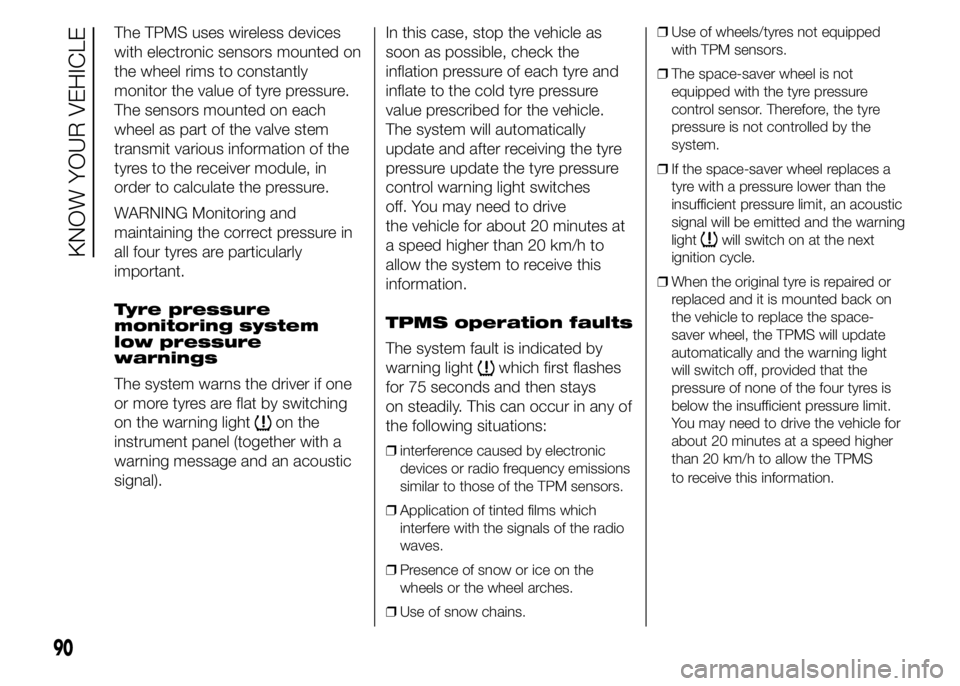
The TPMS uses wireless devices
with electronic sensors mounted on
the wheel rims to constantly
monitor the value of tyre pressure.
The sensors mounted on each
wheel as part of the valve stem
transmit various information of the
tyres to the receiver module, in
order to calculate the pressure.
WARNING Monitoring and
maintaining the correct pressure in
all four tyres are particularly
important.
Tyre pressure
monitoring system
low pressure
warnings
The system warns the driver if one
or more tyres are flat by switching
on the warning light
on the
instrument panel (together with a
warning message and an acoustic
signal).In this case, stop the vehicle as
soon as possible, check the
inflation pressure of each tyre and
inflate to the cold tyre pressure
value prescribed for the vehicle.
The system will automatically
update and after receiving the tyre
pressure update the tyre pressure
control warning light switches
off. You may need to drive
the vehicle for about 20 minutes at
a speed higher than 20 km/h to
allow the system to receive this
information.
TPMS operation faults
The system fault is indicated by
warning light
which first flashes
for 75 seconds and then stays
on steadily. This can occur in any of
the following situations:
❒interference caused by electronic
devices or radio frequency emissions
similar to those of the TPM sensors.
❒Application of tinted films which
interfere with the signals of the radio
waves.
❒Presence of snow or ice on the
wheels or the wheel arches.
❒Use of snow chains.❒Use of wheels/tyres not equipped
with TPM sensors.
❒The space-saver wheel is not
equipped with the tyre pressure
control sensor. Therefore, the tyre
pressure is not controlled by the
system.
❒If the space-saver wheel replaces a
tyre with a pressure lower than the
insufficient pressure limit, an acoustic
signal will be emitted and the warning
light
will switch on at the next
ignition cycle.
❒When the original tyre is repaired or
replaced and it is mounted back on
the vehicle to replace the space-
saver wheel, the TPMS will update
automatically and the warning light
will switch off, provided that the
pressure of none of the four tyres is
below the insufficient pressure limit.
You may need to drive the vehicle for
about 20 minutes at a speed higher
than 20 km/h to allow the TPMS
to receive this information.
90
KNOW YOUR VEHICLE